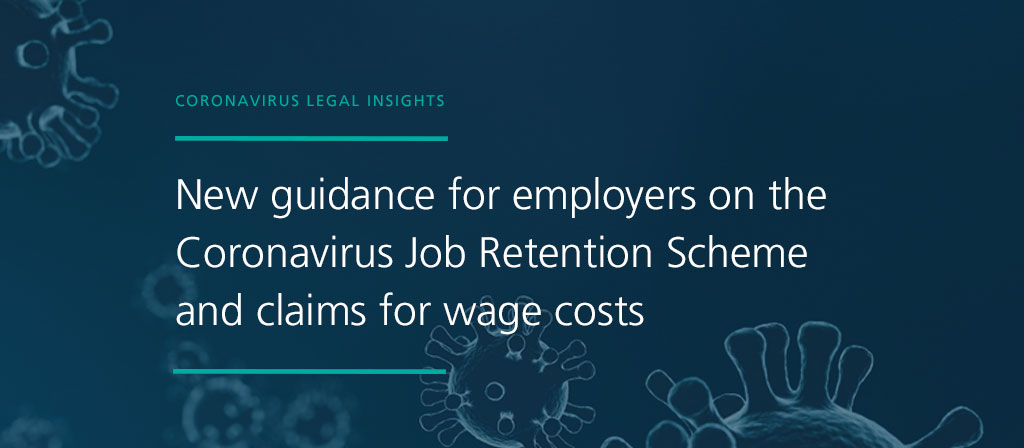Coronavirus Job Retention Scheme: New guidance from government

The government has published further details of the Coronavirus Job Retention Scheme (also known as the ‘furlough scheme’) as part of the emergency measures surrounding the coronavirus outbreak.
The Coronavirus Job Retention Scheme is a temporary scheme open to employers for at least three months starting from 1 March 2020.
The following is just a summary of the main points (and click here to read further clarification which has emerged since we wrote this article).
Who can claim?
- Any organisation (businesses, charities, public authorities, agencies where workers are paid through PAYE and are not working, etc) with employees can apply under the scheme so long as they created and started a PAYE payroll scheme on, or before, 28 February 2020.
- The government anticipates however, that many public sector organisations will not need to rely on this scheme given their employees are providing essential support to respond to the coronavirus outbreak.
Who does it extend to?
- Furloughed employees must have been on the PAYE payroll on 28 February 2020, irrespective of the type of employment contract. The scheme also covers employees who have been made redundant or who have left for other reasons since that date – they can be rehired and then furloughed.
- Employees who are self-isolating cannot be placed on furlough – they should be receiving sick pay. However they can be furloughed after they return from sick leave.
- The scheme does not cover employees on unpaid leave, unless they were placed on unpaid leave after 28 February 2020.
- Normal statutory maternity pay rules apply to employees on maternity/paternity leave (or similar). There does not appear to be anything in the guidance preventing a woman on maternity leave agreeing to return to work, or switching to shared parental leave, and then being furloughed.
- Company directors can be furloughed, if they are paid via PAYE. While they can still perform their statutory duties (which, in practice, will be very limited activities), they must not carry out other work for the company.
- Employees are able to start a new job when on furlough (meaning they might end up earning 80% of the old salary and 100% of a new one) provided that is permitted by their employment contract. Alternatively, employers may choose to temporarily waive any restrictions preventing employees from working elsewhere whilst employed by them.
What is the process?
- To be eligible for the subsidy employers should write to their employee confirming that they have been furloughed and keep a record of this communication for at least five years. Be careful not to discriminate when deciding who to offer furlough to; however it’s probably alright to prioritise ‘at risk’ groups. In most cases (particularly where pay and benefits are being reduced) furloughing will need to be done by agreement.
- When on furlough, an employee cannot work for their employer. If an employee is working, even for a minimal amount of time, employers will not be able to claim under this scheme. Training and volunteering (so long as it isn’t directly benefiting the organisation) are not considered ‘working’. Employees training under furlough should be compensated (national minimum wage applies in that instance).
- Employers can reclaim up to 80% of wage costs, including ‘compulsory’ (presumably meaning contractual) commission, up to a cap of £2,500 per month, plus (not including) the associated employer NICs and minimum auto-enrolment pension contributions on that wage.
- The scheme does not cover bonuses and non-monetary benefits (eg car allowance and health insurance perks) but does make provisions for fees to be reclaimed.
- Employers can top up to 100% of salary, but do not have to.
- Employees are only entitled to the minimum wage for the hours they work. So if they are furloughed and do not work, and 80% of their normal earnings would take them below the minimum wage based on their normal working hours, they still only receive 80% as they are not working.
- Where an employee’s pay varies, the employer can claim for the higher of either (a) the same month’s earning from the previous year or (b) the average monthly earnings from the 2019-20 tax year. If they have been employed for less than a year, the employer should claim for an average of their monthly earnings since they started work.
- The guidance does not appear to prohibit rotating employees through furlough leave, although each employee would need to be off for a minimum of three weeks. It has now been clarified that employees can be furloughed multiple times, i.e. they can be furloughed, brought back to work, then re-furloughed, provided that each furlough period lasts for at least three weeks.
- Where employees have more than one employer, they can be furloughed for each position. As both jobs are separate, the cap applies to both employers individually.
- Employers can claim from the scheme once every three weeks, which is the minimum length an employee can be furloughed for. Claims can be backdated to 1 March 2020. It has now been clarified that claims should be started from the date that the employee finishes work and starts furlough, not when the decision to furlough is made, or when they were written to confirming their furloughed status.
- Employees that have been furloughed have the same rights as they did previously. That includes statutory sick pay entitlement, maternity rights, other parental rights, rights against unfair dismissal and to redundancy payments.
- HMRC have published guidance concerning furlough leave and annual leave. Read the updated position here.
When can an employer claim?
- The government went live with the claims portal on 20 April 2020.
- Once HMRC have received your claim and you are eligible for the grant, they will pay it via BACS payment to a UK bank account.
Full guidance set out by the government and more details about how to claim can be read here.
We’re here to help
We appreciate that it is a confusing and uncertain times for employers, but we’re here to help.
Our employment law team is fully equipped to advise you on your rights and obligations in this most unusual situation and how best to implement this guidance across your workforce.
Our legal services are operating as normal, with all of our lawyers able to work safely from home.
Please call 01242 514000 or email our lead employment partner on matthew.clayton@willans.co.uk and we will be delighted to help.
We’re regularly updating our website with more COVID-19 legal insights, so keep an eye on willans.co.uk/insight for the latest legal perspectives relating to the coronavirus.
Contact
Matthew Clayton MA LLM (Cantab), CIPP/E
Partner
View profile


Related services
Share this article
Home Office begins eVisa rollout
The Home Office has started to roll out eVisas, with their aim being to have replaced physical visas or biometric residence permits (BRPs) by 2025. The Home Office has started…
Hayley Ainsworth BA, MSc
Associate, solicitor

Flexible working is here to stay from 6 April 2024
From 6 April, flexible working laws are changing, making it easier for employees to make statutory flexible working requests. The Employment Relations (Flexible Working) Act 2023 will make the following…
Hayley Ainsworth BA, MSc
Associate, solicitor

Business Immigration: Significant changes to take place in April 2024
Last December, the Home Secretary announced a five-point plan to reduce immigration in the UK, with most measures to be implemented early this year. Tomorrow, these significant changes to business…
Klára Grmelová MGR (LLM Czech)
Solicitor









